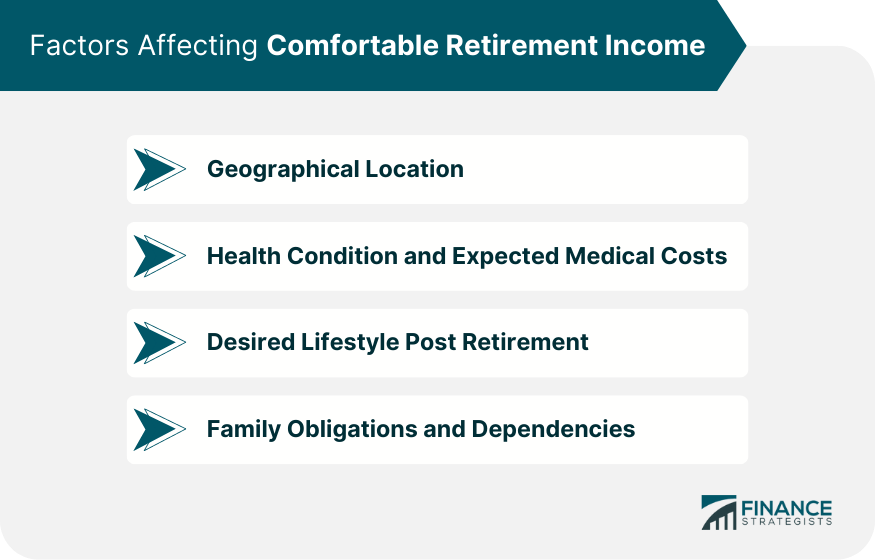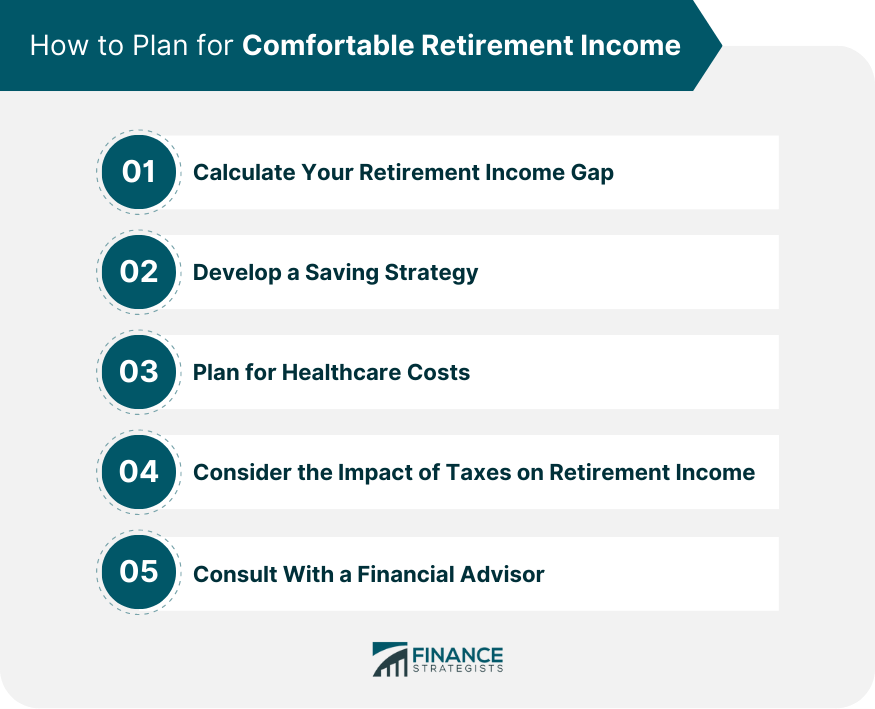A comfortable income in retirement varies depending on individual circumstances and lifestyle choices. However, a general guideline suggests aiming for a retirement income that replaces about 70-80% of your pre-retirement salary. To achieve this, financial experts often recommend having retirement savings that can generate an annual income of 25-30 times your desired retirement expenses. For example, if you anticipate needing $50,000 per year in retirement, a savings range of $1.25 million to $1.5 million would be suggested. It's crucial to consider factors like healthcare costs, inflation, and any additional sources of income, such as pensions or Social Security benefits, when determining the ideal amount for a comfortable retirement income. To figure out what a comfortable retirement income might look like, understand your retirement needs. Basic needs include food, shelter, utilities, and healthcare. Yet, comfort in retirement is not solely about meeting our basic needs. It's about maintaining the lifestyle to which we've become accustomed, which can include expenses related to travel, hobbies, and social activities. Additionally, unexpected costs, such as home repairs or medical emergencies, can also arise. As such, a comfortable retirement income should take into account these potential unexpected costs, providing a buffer to handle any financial surprises that come your way. Inflation and changes in the cost of living can significantly impact the purchasing power of your retirement income. For example, $50,000 today won't buy as much in 30 years if inflation averages 2% per year. Therefore, your retirement planning should account for potential inflation and increases in the cost of living. A common rule of thumb in retirement planning is the '70-80% rule', which suggests that retirees will need 70-80% of their pre-retirement income to maintain their standard of living in retirement. While this rule can provide a starting point, everyone's retirement needs and dreams are different, so personalizing your retirement income goals is crucial. The cost of living can vary greatly depending on where you decide to retire. For example, retiring in a large city like New York or San Francisco is likely to require a higher income than retiring in a smaller, less expensive city. Similarly, taxation can vary between different states and countries. Understanding these factors can help you more accurately plan for your retirement income needs. As we age, healthcare often becomes a more significant expense. Chronic conditions, medications, or potential long-term care needs can significantly impact the income needed for a comfortable retirement. How you want to live in retirement plays a big role in determining a comfortable retirement income. If you plan to travel extensively or have costly hobbies, you will likely need a higher income than if your retirement plans are more modest. Your family situation is another important consideration. If you anticipate supporting family members financially in your retirement or leaving an inheritance, these goals will affect the income you need. For many retirees, Social Security benefits provide a significant portion of their retirement income. However, relying solely on Social Security is unlikely to provide a comfortable retirement income. The exact amount you receive will depend on your earnings history and the age at which you begin claiming benefits. Pension plans can provide a stable source of retirement income. However, the availability of pension plans has decreased over time, and they are less likely to be a significant source of income for future retirees. Retirement savings accounts like 401(k)s and Individual Retirement Accounts (IRAs) often form a large part of retirement income. The income these accounts can generate depends on the amount saved and the returns achieved. Investments outside of traditional retirement accounts can also generate income in retirement. This might include income from stocks, bonds, rental properties, or other investments. The income from these sources can vary based on market conditions. Some retirees choose to continue working part-time or start a new career in retirement. This can provide additional income and can also offer social engagement and a sense of purpose. First, estimate your retirement expenses, taking into account the factors discussed earlier. Next, estimate your income from Social Security, pensions, savings, and investments. The difference between these two amounts is your retirement income gap. The earlier you start planning for retirement, the better. Due to the power of compound interest, even small amounts saved early can grow significantly over time. It's also essential to diversify your income streams to mitigate risk. Anticipate and plan for potential healthcare costs in retirement. This might include purchasing long-term care insurance or setting aside savings specifically for healthcare expenses. Taxes can significantly impact your retirement income. Understanding the tax implications of your retirement savings and withdrawal strategies can help maximize your retirement income. A financial advisor can help you navigate the complexities of retirement planning, ensuring you consider all factors and make informed decisions. Underestimating the Length of Retirement: With increasing life expectancies, many of us can expect to live 20-30 years in retirement. Planning for a long retirement can help ensure you don't outlive your savings. Not Accounting for Inflation: Ignoring inflation can leave you with less purchasing power in retirement. Including inflation in your retirement planning can help maintain your standard of living. Ignoring Healthcare Costs: Healthcare costs can be high in retirement and increase as you age. Accounting for these costs can help ensure they don't derail your retirement plans. Not Diversifying Income Sources: Reliance on a single source of income, such as Social Security or a 401(k), can leave you vulnerable to changes in benefit levels or market downturns. Diversifying your income sources can help provide financial stability in retirement. Determining a comfortable income in retirement requires careful planning and a nuanced understanding of your personal goals, expenses, and lifestyle. Remember, the '70-80% rule' is a guideline, but each person's needs are unique. Prioritize understanding your retirement needs, factoring in basic and lifestyle costs, as well as unexpected expenses. Consider the impact of inflation, cost of living changes, geographical location, health conditions, desired post-retirement lifestyle, and family obligations on your income needs. Diversify your income sources with Social Security benefits, pensions, retirement savings, investments, and potentially part-time work. Start planning early, take healthcare costs and tax implications into account, and consider consulting with a financial advisor. Avoid common mistakes such as underestimating retirement length, neglecting inflation, ignoring healthcare costs, and relying on a single income source. By navigating these complexities, you can secure a more comfortable and financially stable retirement.What Is a Comfortable Income in Retirement?
What Constitutes a Comfortable Income in Retirement?
Retirement Income Needs
Inflation and Cost of Living Changes
The '70-80% Rule' in Retirement Income
Factors Affecting Comfortable Retirement Income
Geographical Location
Health Condition and Expected Medical Costs
Desired Lifestyle Post Retirement
Family Obligations and Dependencies

Sources of Retirement Income
Social Security Benefits
Pension Plans
Retirement Savings - 401(k), IRA
Investments - Stocks, Bonds, Real Estate
Part-Time Work or Post-Retirement Jobs
How to Plan for Comfortable Retirement Income
Calculating Your Retirement Income Gap
Developing a Saving Strategy
Planning for Healthcare Costs
Considering the Impact of Taxes on Retirement Income
Consulting With a Financial Advisor

Mistakes to Avoid When Planning for Retirement Income
Conclusion
What Is a Comfortable Income in Retirement? FAQs
A comfortable income in retirement typically means having enough money to maintain your desired lifestyle without financial stress. You can estimate it by first understanding your retirement needs, including basic needs, lifestyle costs, and unexpected expenses. Then, factor in inflation, geographical location, health conditions, and desired lifestyle post-retirement. A common starting point is the '70-80% rule', suggesting you'll need 70-80% of your pre-retirement income.
The main sources of retirement income typically include Social Security benefits, pension plans, retirement savings like 401(k)s and IRAs, investments such as stocks, bonds, and real estate, and potential income from part-time work or post-retirement jobs. Diversifying your sources of income can help create a more secure and comfortable income in retirement.
Key factors affecting a comfortable retirement income include geographical location (which affects the cost of living and taxation), health condition and anticipated medical costs, desired lifestyle post-retirement, and family obligations. Inflation and changes in the cost of living over time are also significant factors.
Common mistakes include underestimating the length of retirement, not accounting for inflation, ignoring healthcare costs, and not diversifying income sources. Each of these can impact the amount of income needed to live comfortably in retirement and should be carefully considered in retirement planning.
Strategies include starting to save early to take advantage of compound interest, diversifying your income streams, planning for healthcare costs, considering the impact of taxes on retirement income, and consulting with a financial advisor. It's also important to avoid common retirement planning mistakes and to stay flexible and adaptable with your plans.
True Tamplin is a published author, public speaker, CEO of UpDigital, and founder of Finance Strategists.
True is a Certified Educator in Personal Finance (CEPF®), author of The Handy Financial Ratios Guide, a member of the Society for Advancing Business Editing and Writing, contributes to his financial education site, Finance Strategists, and has spoken to various financial communities such as the CFA Institute, as well as university students like his Alma mater, Biola University, where he received a bachelor of science in business and data analytics.
To learn more about True, visit his personal website or view his author profiles on Amazon, Nasdaq and Forbes.











